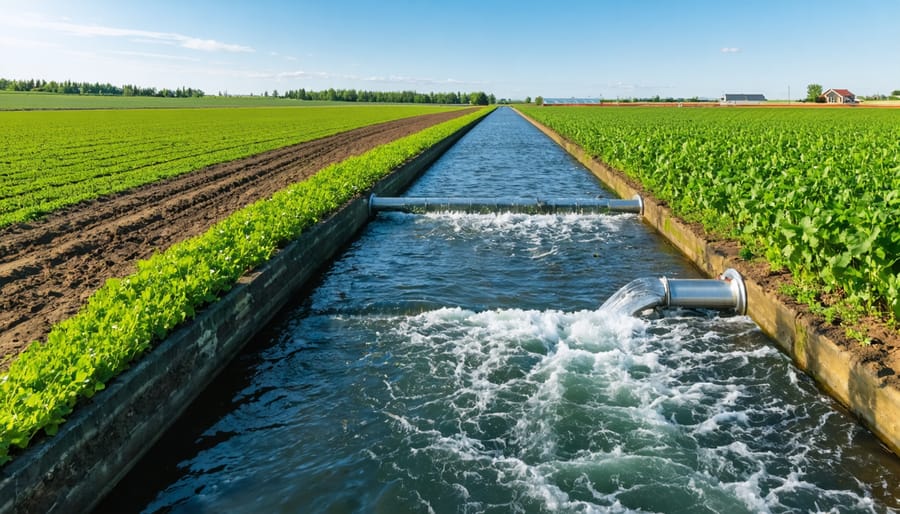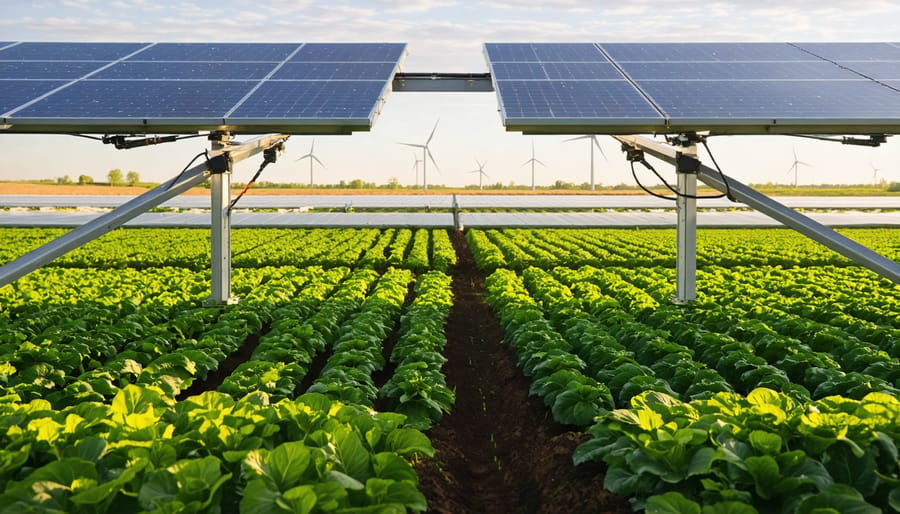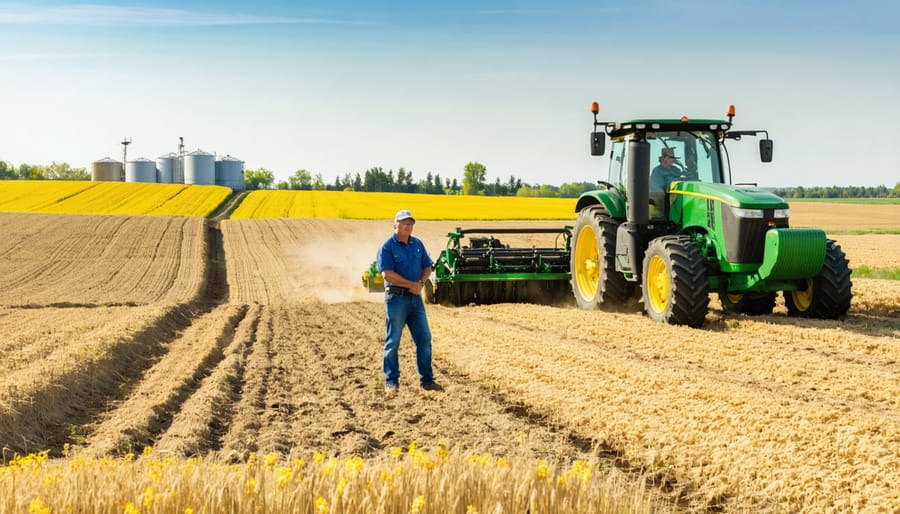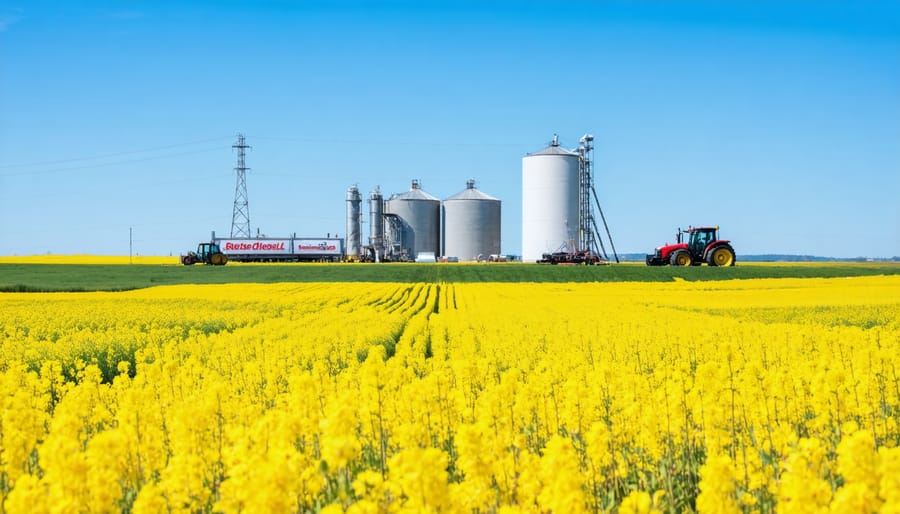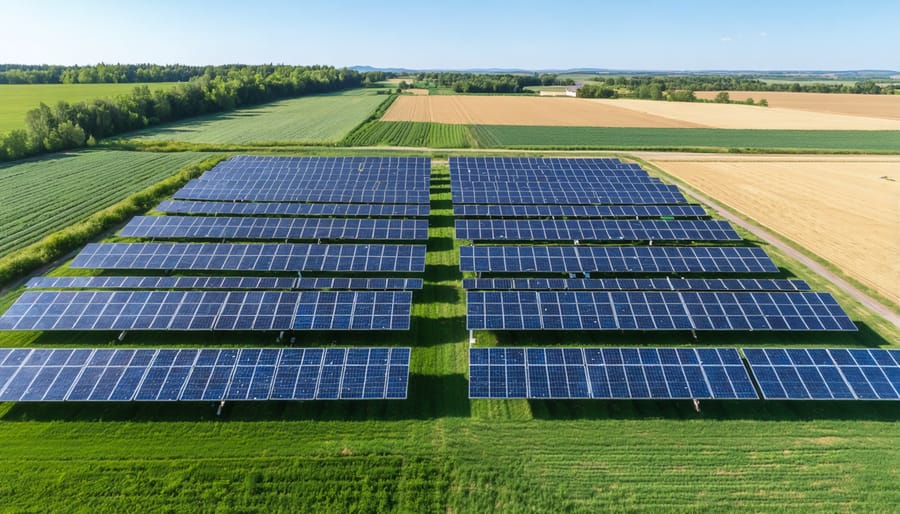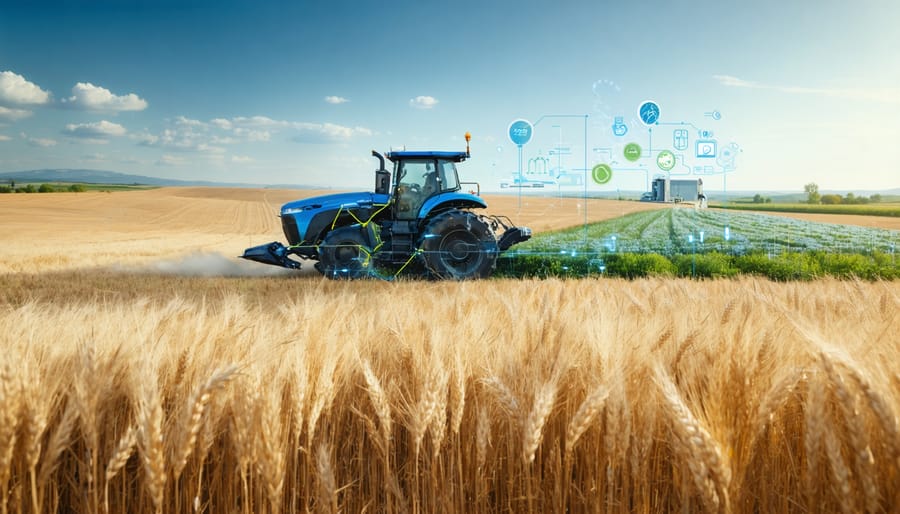Transform your farming operation into a sustainable powerhouse by harnessing the diverse potential of renewable energy systems across Alberta’s agricultural landscape. As Canadian farmers increasingly integrate aquatic renewable energy systems and other clean power solutions, the path to energy independence has never been clearer.
From the sun-drenched prairies to fast-flowing irrigation channels, Alberta farms are uniquely positioned to leverage multiple renewable energy sources. Our province’s agricultural sector already leads the country in renewable energy adoption, with over 500 farm-based installations generating clean power while reducing operational costs by an average of 40%.
Whether you’re looking to power a small greenhouse operation or a large-scale grain facility, understanding these seven renewable energy types will help you make informed decisions for your farm’s future. Each solution has been tested and proven on Canadian farms, with real-world performance data and practical implementation strategies specific to our regional conditions.
Let’s explore these sustainable power sources that are reshaping Alberta’s agricultural landscape, backed by local success stories and concrete implementation guidance tailored to your farming operation.
Hydropower: Small-Scale Solutions for Farm Waterways
Converting Irrigation Channels to Power Sources
Farmers across Alberta are discovering innovative ways to generate power from their existing irrigation infrastructure. By installing micro-turbines in irrigation channels, agricultural operations can harness flowing water to produce clean electricity while maintaining regular water delivery for crops.
Take the Anderson family farm near Lethbridge, for example. By retrofitting their main irrigation canal with a 50kW micro-hydro system, they now generate enough power to run their grain storage facility and workshop. The installation cost was offset by provincial renewable energy grants, with the system paying for itself within four years through reduced electricity bills.
The key to success lies in identifying channels with sufficient water flow and vertical drop. Most suitable locations are where water drops at least 2 metres over a reasonable distance. Modern micro-turbine systems are fish-friendly and don’t impede water flow, making them environmentally sound choices for irrigation networks.
Local irrigation districts are increasingly supporting these initiatives by providing technical assessments and connecting farmers with qualified installers. The Southern Alberta Irrigation Projects Association reports that over 25 farms in the region have successfully implemented similar systems in the past three years.
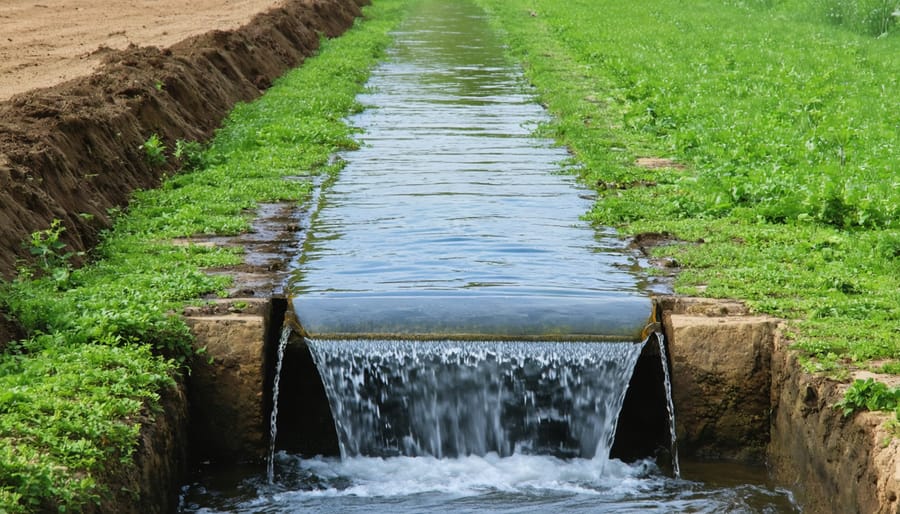
Success Story: Mountain View Farm’s Micro-Hydro Installation
In 2019, the Robertson family of Mountain View Farm near Red Deer, Alberta, transformed their irrigation challenges into an energy opportunity by installing a micro-hydro system on their 640-acre property. Using the natural 12-metre elevation drop from their upstream water source, they implemented a 5kW system that now powers their entire dairy operation.
The installation cost $45,000, with 30% covered by Alberta’s On-Farm Energy Management Program. Sarah Robertson, the farm’s co-owner, reports that the system generates approximately 43,800 kWh annually, saving them $5,250 in electricity costs each year.
“We’re particularly proud that our system runs year-round, even in winter, thanks to our insulated powerhouse and heated intake system,” explains Robertson. “The consistent water flow from our irrigation system means we have reliable power generation even during peak usage periods.”
The project has inspired neighbouring farms, with three other local operations now exploring similar installations. Mountain View Farm regularly hosts educational tours for agricultural students and farmers interested in renewable energy solutions, demonstrating how traditional farming practices can embrace sustainable technology.
Wave Energy: Coastal and Lakeside Applications
For farms situated near large water bodies like the Great Lakes or along Canada’s extensive coastlines, wave energy presents an exciting renewable energy opportunity. This technology harnesses the consistent motion of waves to generate electricity, offering a reliable power source that complements other renewable systems.
Here in Canada, we’re seeing growing interest in wave energy applications, particularly in coastal regions of British Columbia and Nova Scotia. While Alberta may be landlocked, farmers with properties near large lakes can still benefit from smaller-scale wave energy systems, especially during ice-free months.
Take the Morrison family farm near Lake Huron, Ontario, for example. They installed a wave energy converter in 2021, which now supplies about 30% of their dairy operation’s power needs. The system consists of floating buoys that move with the waves, driving generators that convert this motion into electricity.
For lakeside farms, wave energy systems typically require:
– A minimum wave height of 1 metre
– Water depth of at least 20 metres
– Proper permits from local authorities
– Initial investment of $50,000-100,000 for small-scale systems
The technology works particularly well when combined with other renewable sources, creating a robust energy mix. Wave energy’s main advantage is its predictability – waves are more consistent than wind or solar, providing steady power output throughout the day and night.
While implementation costs remain higher than some other renewable options, government incentives and grants are available to help offset initial expenses. The Canadian Water Power Association offers support for farmers interested in exploring wave energy solutions, including feasibility studies and technical guidance.
Tidal Energy: Opportunities for Coastal Regions
For coastal farming operations, tidal energy presents a unique opportunity to harness the predictable power of ocean currents. Unlike wind or solar power, tidal energy offers consistent and reliable power generation, making it particularly valuable for agricultural operations that require steady energy supply for irrigation systems and processing facilities.
In Atlantic Canada, several farming communities have already begun exploring tidal power systems. The Bay of Fundy, with its world-record tides reaching up to 16 metres, demonstrates the incredible potential for coastal agricultural operations. Local farmers have partnered with marine energy developers to install underwater turbines that generate electricity during both incoming and outgoing tides.
These systems typically consist of either horizontal or vertical turbines anchored to the seabed. The most common setup for agricultural applications involves smaller-scale turbines connected to a power station on shore, which then feeds directly into farm operations. This arrangement can support everything from greenhouse climate control to aquaculture pump systems.
Maritime farmers report that tidal energy systems can reduce operational costs by 30-40% compared to conventional power sources. While initial installation costs are significant, typically ranging from $100,000 to $500,000 depending on scale, government incentives and grants are available to help offset these expenses.
For coastal farmers considering tidal energy, it’s essential to conduct thorough site assessments to determine tidal flow patterns and potential energy yield. Environmental impact studies are also required to ensure marine life protection. Working with local marine energy specialists and connecting with other farmers who have implemented these systems can provide valuable insights for successful installation and operation.
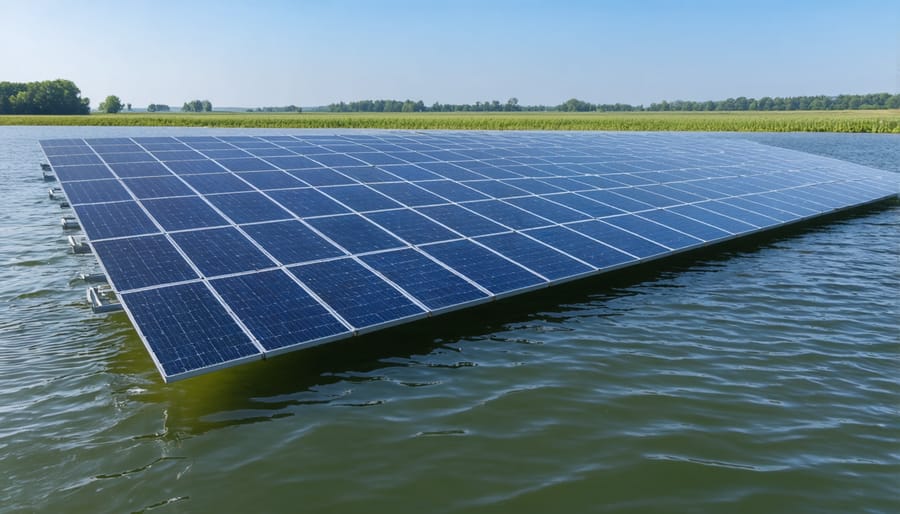
Floating Solar Arrays: Dual-Purpose Water Management
Reducing Evaporation While Generating Power
Floating solar systems are proving to be a game-changer for Alberta farmers with irrigation ponds and reservoirs. These innovative systems not only generate clean energy but also reduce water loss through evaporation by up to 70%. When solar panels float on water surfaces, they create a protective barrier that shields the water from direct sunlight and wind exposure.
For example, the Morrison Farm near Lethbridge installed a 250kW floating solar system on their irrigation pond in 2022. They reported a 60% reduction in water loss while generating enough power to run their entire irrigation system during peak growing season. The cooler water environment also helps maintain optimal panel temperature, increasing energy production efficiency by roughly 10% compared to land-based systems.
These dual-purpose systems are particularly valuable during our hot prairie summers when both power demand and evaporation rates peak. The shade provided by the panels also helps reduce algae growth, improving water quality for irrigation. Many farmers find that the initial investment pays off through both energy savings and reduced water consumption, making it an increasingly popular choice for sustainable farm management.
Biomass Energy from Aquatic Plants
Aquatic plants offer an innovative approach to renewable energy production that’s gaining traction among Alberta farmers with access to wetlands or water bodies. These plants, including duckweed, algae, and water hyacinth, can be harvested and converted into biofuel through various processes.
Here in Alberta, several farmers are already experimenting with controlled pond systems to grow and harvest duckweed, which produces up to 10 times more biomass per hectare than traditional land-based energy crops. The best part? These systems can operate alongside existing agricultural operations without competing for valuable farmland.
The process involves collecting aquatic plants, which are then dried and processed into pellets or converted into biogas through anaerobic digestion. A notable success story comes from the Morrison family farm near Red Deer, where they’ve integrated a 2-hectare duckweed pond into their operations, producing enough biomass to offset 15% of their farm’s energy needs.
The benefits extend beyond energy production. These aquatic systems help filter agricultural runoff, reduce greenhouse gas emissions, and provide additional income streams through carbon credits. Local agricultural extension services offer support programs for farmers interested in implementing these systems, including technical guidance and potential funding opportunities.
While initial setup costs can range from $5,000 to $15,000 per hectare, many farmers report breaking even within 3-5 years through reduced energy costs and environmental incentives.
Wastewater-to-Energy Systems
On Alberta farms, wastewater isn’t just a disposal challenge – it’s becoming a valuable energy resource. Through innovative agricultural waste-to-energy conversion systems, farmers are transforming livestock manure and crop processing wastewater into biogas and electricity.
The process begins with anaerobic digestion, where bacteria break down organic matter in oxygen-free tanks, producing methane-rich biogas. This biogas can power generators for electricity or be refined into natural gas alternatives. A typical 200-head dairy farm in Alberta can generate enough biogas to power 25-30 homes annually.
Local success stories include the Lethbridge Biogas facility, which processes wastewater from nearby cattle operations to power over 2,800 homes. Beyond biogas, advanced treatment systems also recover nutrients like nitrogen and phosphorus, creating valuable fertilizer byproducts.
Getting started with wastewater-to-energy doesn’t require massive infrastructure. Many Alberta farmers begin with simple lagoon digesters, gradually scaling up as they see returns. Provincial grants currently cover up to 40% of system installation costs, making the technology increasingly accessible.
The benefits extend beyond energy production. These systems reduce greenhouse gas emissions from conventional wastewater management, minimize odours, and improve local water quality. They also provide steady income through power generation credits and fertilizer sales.
For farms considering implementation, local agricultural extension offices offer free consultations to assess feasibility and connect with experienced system operators. The technology continues to evolve, with new developments in membrane filtration and algae cultivation promising even greater energy yields from farm wastewater.
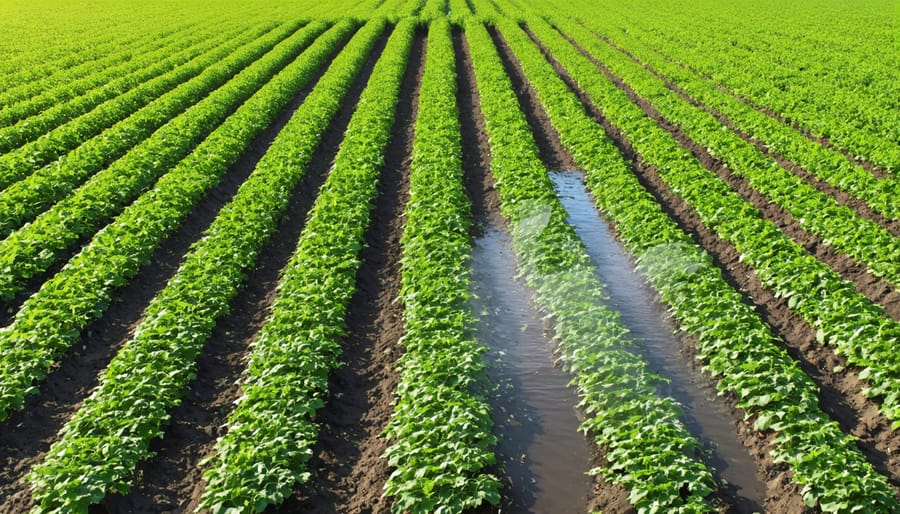
Integrating Multiple Aquatic Energy Sources
For Alberta farmers looking to maximize their water-based energy potential, combining multiple aquatic energy sources can create a more reliable and efficient power system. Many successful farms are now integrating hydroelectric microgrids with other water-based systems like wave energy capture and micro-hydro installations.
The key to successful integration lies in understanding your property’s unique water resources. For example, farms along the Bow River Valley can combine small-scale hydroelectric generation with water storage systems that serve both irrigation and power generation needs. During peak flow seasons, excess energy can be stored in batteries or used to pump water to elevated storage for later use.
Many Alberta farmers have found success by starting with a single system, such as a micro-hydro installation, and gradually adding complementary technologies. This approach allows for better budget management and system optimization over time. Some innovative combinations include:
– Pairing micro-hydro with floating solar panels on irrigation ponds
– Combining water pumping windmills with small hydroelectric turbines
– Installing heat exchange systems alongside water power generation
Local agricultural extension services can help assess your property’s potential for multiple water-based energy systems and provide guidance on integration strategies that work best for your specific situation.
The future of aquatic renewable energy in Canadian agriculture shines bright, offering farmers sustainable solutions that work in harmony with our natural water resources. From the success stories we’ve seen across Alberta to the growing network of farmers embracing these technologies, water-based renewable energy is proving to be a game-changer for agricultural operations.
By integrating these systems, Canadian farmers are not only reducing their energy costs but also contributing to environmental conservation. The combination of micro-hydro power, wave energy, and innovative irrigation systems has shown potential energy savings of 30-40% for participating farms, while maintaining or improving crop yields.
Looking ahead, government incentives and advancing technologies are making these systems more accessible and efficient. The community of early adopters in regions like Southern Alberta has created valuable knowledge-sharing networks, helping fellow farmers navigate implementation challenges and maximize benefits.
As climate patterns continue to evolve, these water-based energy solutions offer both resilience and sustainability. They represent not just an environmental choice, but a smart business decision for the future of Canadian farming. With growing support from agricultural organizations and increasing expertise in installation and maintenance, there’s never been a better time for farmers to explore these innovative energy solutions.

